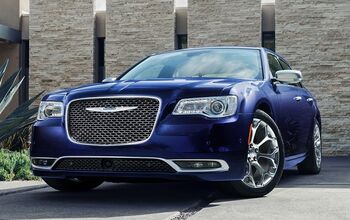Electric AWD on the Way For Chrysler Minivans, Report Says

Earlier this year, when rumors of a forthcoming all-wheel drive Chrysler Pacifica arose, the minivan segment seemed ready to birth a rival to Toyota’s AWD Sienna. Instead, Chrysler ended up debuting a stripped-down version of the FWD Pacifica called the Voyager.
AWD isn’t off the table, it seems, but the traditional form of all-wheel traction is. A new report claims the coming year will bring an electrified AWD minivan from Windsor Assembly.
According to sources tapped by MoparInsiders, 2020 will see the unveiling of a refreshed Pacifica with optional eAWD — a modern solution that avoids the often tricky process of sending a propshaft aft to the rear axle. This was the reason Fiat Chrysler didn’t offer an AWD Pacifica from the outset. FCA officials claimed adding traditional mechanical AWD would mean foregoing the model’s Stow & Go rear seats, which happen to be a key selling feature.
Adding an eAWD system that powers the rear wheels electrically, independent of the front-mounted engine/transmission (like that found in new Toyota crossovers and hybridized versions of the Jeep Compass and Renegade introduced in Europe), means the fancy disappearing seats can stay. Suddenly, the model can boast two attractive features.
The forthcoming refreshed Pacifica and Voyager will appear later in 2020, MI claims, going on sale as a 2021 model-year vehicle. Besides the addition of an AWD hybrid model, the minivans will boast updated styling that hints at the soon-to-depart Dodge Grand Caravan. That model, a mainstay in the FCA stable, is expected to die at some point next year.
With the Grand Caravan gone, the Pacifica and low-priced Voyager will have to take on that minivan’s loyal customers. As such, the Chrysler duo’s grille is expected to grow larger and more pronounced, not entirely unlike the Chrysler 300. Headlights stand to become slimmer, with LED lighting standard at least on the Pacifica.
Will the creation of an AWD FCA minivan boost flagging sales? Perhaps for the Pacifica nameplate, but the loss of the Grand Caravan — by far FCA’s biggest minivan seller — will surely see the automaker’s overall minivan volume fall. Through the first three-quarters of 2019, Americans bought over 99,000 Grand Caravans and just over 70,000 Pacificas. Those year-to-date sales tallies are down 18 and 23 percent, respectively.
[Image: Fiat Chrysler]

More by Steph Willems
Latest Car Reviews
Read moreLatest Product Reviews
Read moreRecent Comments
- Funky D The problem is not exclusively the cost of the vehicle. The problem is that there are too few use cases for BEVs that couldn't be done by a plug-in hybrid, with the latter having the ability to do long-range trips without requiring lengthy recharging and being better able to function in really cold climates.In our particular case, a plug-in hybrid would run in all electric mode for the vast majority of the miles we would drive on a regular basis. It would also charge faster and the battery replacement should be less expensive than its BEV counterpart.So the answer for me is a polite, but firm NO.
- 3SpeedAutomatic 2012 Ford Escape V6 FWD at 147k miles:Just went thru a heavy maintenance cycle: full brake job with rotors and drums, replace top & bottom radiator hoses, radiator flush, transmission flush, replace valve cover gaskets (still leaks oil, but not as bad as before), & fan belt. Also, #4 fuel injector locked up. About $4.5k spread over 19 months. Sole means of transportation, so don't mind spending the money for reliability. Was going to replace prior to the above maintenance cycle, but COVID screwed up the market ( $4k markup over sticker including $400 for nitrogen in the tires), so bit the bullet. Now serious about replacing, but waiting for used and/or new car prices to fall a bit more. Have my eye on a particular SUV. Last I checked, had a $2.5k discount with great interest rate (better than my CU) for financing. Will keep on driving Escape as long as A/C works. 🚗🚗🚗
- Rna65689660 For such a flat surface, why not get smoke tint, Rtint or Rvynil. Starts at $8. I used to use a company called Lamin-x, but I think they are gone. Has held up great.
- Cprescott A cheaper golf cart will not make me more inclined to screw up my life. I can go 500 plus miles on a tank of gas with my 2016 ICE car that is paid off. I get two weeks out of a tank that takes from start to finish less than 10 minutes to refill. At no point with golf cart technology as we know it can they match what my ICE vehicle can do. Hell no. Absolutely never.
- Cprescott People do silly things to their cars.



































Comments
Join the conversation
Routing a propshaft is hard, but routing electrical wires is much, much harder - probably impossible - which is why this will never work. Ever. ICE forever! (Everyone knows that higher voltage needs thicker wires - good luck sourcing a 4-inch thick copper conductor and routing it along the frame rails to the rear wheels. Will there be multiple humps in the back floor now? These EV things are such a joke. If this was a good idea, Ford would have already done it.)
Since you don't really need AWD while tooling down the highway it makes sense to do it this way. Especially if they use the tech from the eTorque models that don't use a very large battery, unlike the plug in hybrid Pacifica.